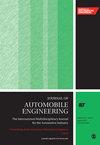Investigative examination of motion sickness indicators for electric vehicles
IF 1.5
4区 工程技术
Q3 ENGINEERING, MECHANICAL
Proceedings of the Institution of Mechanical Engineers Part D-Journal of Automobile Engineering
Pub Date : 2024-05-27
DOI:10.1177/09544070241251521
引用次数: 0
Abstract
Electric vehicles (EVs) pose a heightened risk of inducing motion sickness in passengers compared to conventional internal combustion engine vehicles. With the increasing prevalence of EVs, there is a pressing need for in-depth research on motion sickness in this specific context. To quantitatively assess motion sickness severity in electric vehicle occupants, this study meticulously selected 25 participants exhibiting a high susceptibility to motion sickness for experimental testing. The research endeavors to elucidate the intricate relationship between motion sickness assessment values, electrodermal activity (EDA) signals, and vehicle state signals during motion sickness episodes. Utilizing correlation analysis to scrutinize the interrelation between electrodermal signals and the severity of motion sickness, we advocate employing the mean and variation rate of EDA as objective metrics for characterizing the extent of motion sickness. Furthermore, we introduce the definition of cumulative seat rail vibration acceleration (CVA) as an integral component of this evaluation. Through meticulous correlation analysis, it is ascertained that the change rates of longitudinal vibration cumulative value (CVAx) and EDA exhibit robust correlations, signifying their significance in relation to motion sickness severity. This research not only establishes a theoretical foundation for quantifying motion sickness in electric vehicle occupants but also contributes profound insights into the underlying mechanisms of motion sickness in the context of electric vehicles.电动汽车晕车指标的调查研究
与传统内燃机汽车相比,电动汽车(EV)诱发乘客晕车的风险更高。随着电动汽车的日益普及,迫切需要对这一特定情况下的晕动病进行深入研究。为了定量评估电动汽车乘客晕动病的严重程度,本研究精心挑选了 25 名对晕动病具有高度易感性的参与者进行实验测试。研究致力于阐明晕车评估值、皮电活动(EDA)信号和晕车发作时车辆状态信号之间错综复杂的关系。利用相关性分析来仔细研究皮电信号与晕车严重程度之间的相互关系,我们主张将 EDA 的平均值和变化率作为描述晕车程度的客观指标。此外,我们还引入了累积座椅轨道振动加速度(CVA)的定义,作为该评估的一个组成部分。通过细致的相关性分析,我们确定纵向振动累积值(CVAx)的变化率与 EDA 呈现出稳健的相关性,这表明它们在晕车严重程度方面具有重要意义。这项研究不仅为量化电动汽车乘员的运动病奠定了理论基础,还对电动汽车运动病的内在机制提出了深刻见解。
本文章由计算机程序翻译,如有差异,请以英文原文为准。
求助全文
约1分钟内获得全文
求助全文
来源期刊

CiteScore
4.40
自引率
17.60%
发文量
263
审稿时长
3.5 months
期刊介绍:
The Journal of Automobile Engineering is an established, high quality multi-disciplinary journal which publishes the very best peer-reviewed science and engineering in the field.
 求助内容:
求助内容: 应助结果提醒方式:
应助结果提醒方式:


